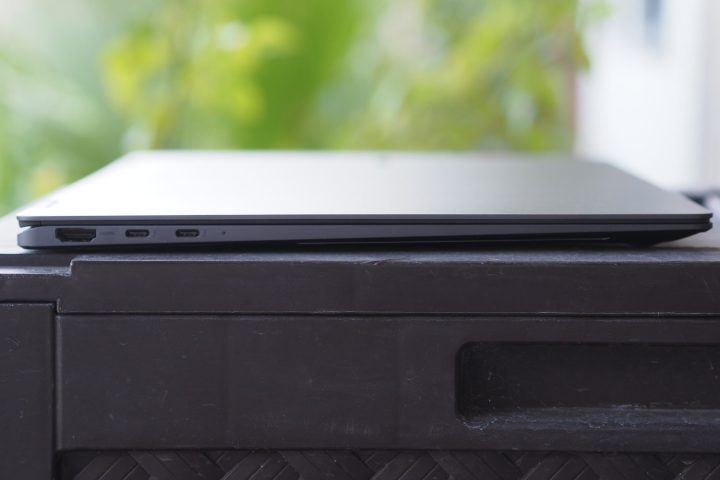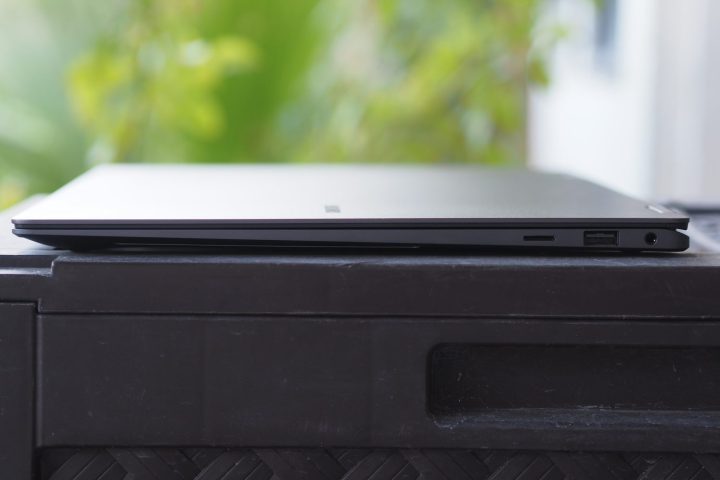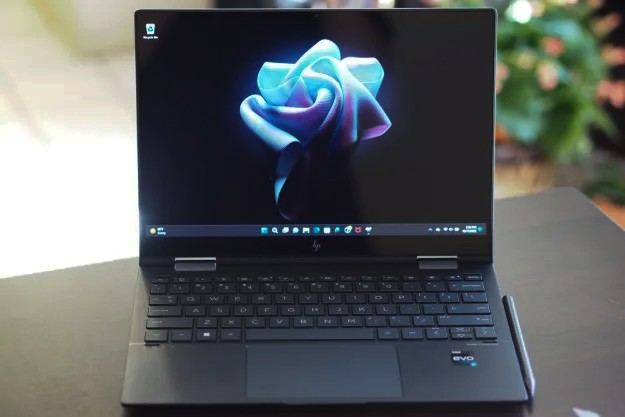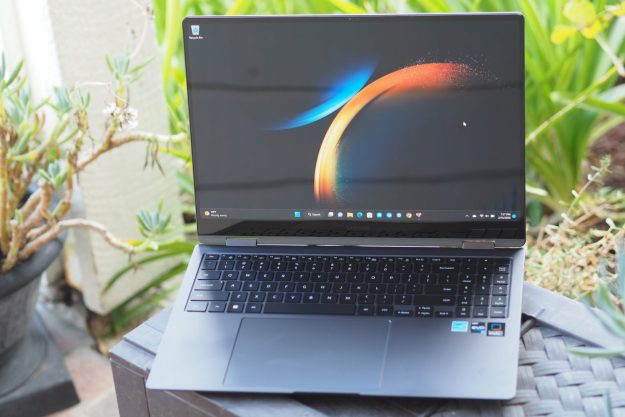
“With a huge OLED screen and ultrathin profile, the Samsung Galaxy Book3 Pro 360 is a delight to ink on.”
- Excellent productivity performance
- Spectacular OLED display
- Solid build quality
- Great battery life
- Outstanding touchpad
- Very thin and light
- Not faster than all 12th-gen Intel machines
- Expensive at list price
Yet another manufacturer has stretched a 15-inch laptop (really, 15.6-inch) into a 16-inch version. The new Samsung Galaxy Book3 Pro 360 gets both a bit of space added to the display and some additional enhancements, resulting in a large convertible 2-in-1 with some attractive features.
It’s also the first laptop we’ve reviewed with Intel’s 13th-gen Raptor Lake CPU inside. The very thin and light design offsets some of the difficulties we’ve encountered with tablets this large in the past, making the Galaxy Book3 Pro 360 a premium 2-in-1 that offers a solid combination of performance and features.
Specs and configurations
| Samsung Galaxy Book3 Pro 360 | |
| Dimensions | 14.0 inches x 9.86 inches x 0.49 inches |
| Weight | 3.3 pounds |
| Processor | Intel Core i7-1360P |
| Graphics | Intel Iris Xe |
| RAM | 8GB LPDDR5 16GB LPDDR5 32GB LPDDR5 |
| Display | 16.0-inch 16:10 3K (2,880 x 1,800) OLED, 120Hz |
| Storage | 256GB SSD 512GB SSD 1TB SSD |
| Touch | Yes |
| Ports | 2 x USB-C with Thunderbolt 4 1 x USB-A 3.2 Gen2 1 x HDMI 1.4 1 x 3.5mm audio jack 1 x microSD card reader |
| Wireless | Wi-Fi 6E and Bluetooth 5.1 |
| Webcam | 1080p |
| Operating system | Windows 11 |
| Battery | 76 watt-hours |
| Price | $1,400+ |
Samsung currently offers two configurations of the Galaxy Book3 Pro 360 for preorder. Both use the Intel 13th-gen Core i7-1360P CPU and the same 16.0-inch 3K OLED display. You can configure 16GB of
Stay tuned for pricing clarifications.
About as usable as a 16-inch 2-in-1 can get
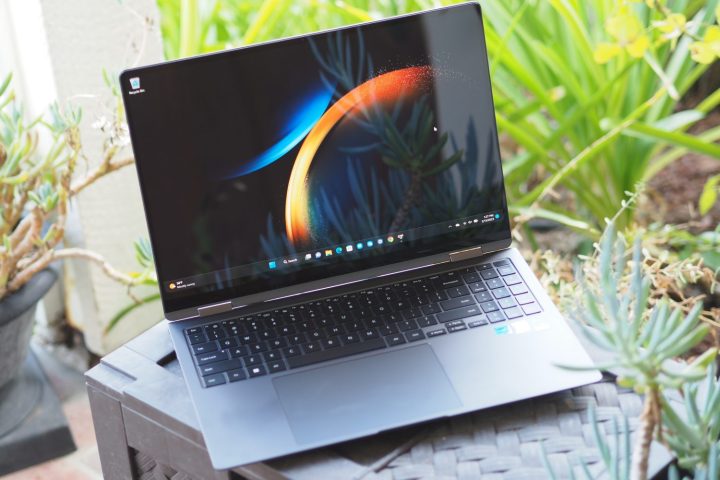
A major competitor for the Galaxy Book3 Pro 360 is the HP Spectre x360 16. That convertible 2-in-1 also sports a 16-inch 16:10 OLED display, albeit a higher-resolution

The Galaxy Book3 Pro 360 is a well-built laptop, with no flexing or bending in the all-aluminum chassis and only a bit of give in the lid. That’s laudable for a laptop that’s so thin and light, and the machine manages to exude both quality and portability. It’s not as solid or dense feeling as the MacBook Pro 16, but that’s OK for a convertible 2-in-1 that’s meant to be handled differently.
The aesthetic is minimalist, with either an all-black (graphite) or a lighter beige color scheme that carries through everywhere except the keyboard on the beige model. There’s zero bling, making for an elegant, understated look that fits well in any environment. The display bezels are thin across the top and sides, but the bottom chin is thicker, as is usually the case on convertible
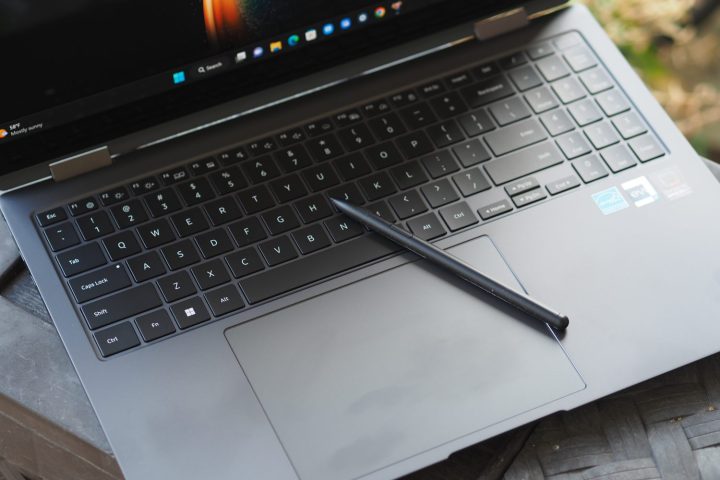
The Galaxy Book3 Pro 360’s keyboard is rather shallow, but offers nicely sized keycaps and plenty of spacing, even with the included numeric keypad. The switches are soft and snappy, providing just enough feedback to feel precise. It’s not as good as the best keyboards in HP’s Spectre or Dell’s XPS lines, nor on the level of Apple’s Magic Keyboard on its latest MacBooks, but it’s still comfortable for long-term typing. The touchpad is huge, taking up all the available space on the palm rest, with quiet but firm and responsive button clicks.
A mix of
Opening this laptop for the first time, it’s impossible to miss all the Samsung apps and utilities meant to tie the laptop with Samsung’s Galaxy phones and Samsung S Pen. Whether these are useful to you or just wasted space remains completely subjective, but they’re unobtrusive and don’t intrude unless you actively turn them on. The S Pen is well-supported if you like to use a pen for taking notes and drawing.
Our first look at Intel’s 13th-gen performance
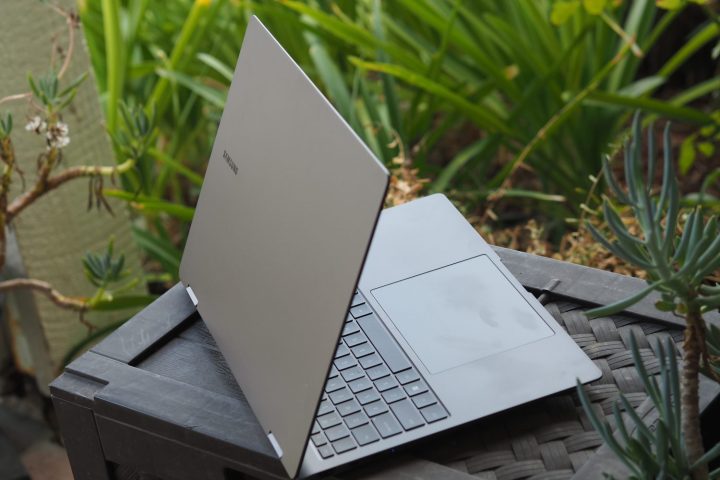
The Galaxy Book3 Pro 360 is equipped with Intel’s 13th-gen Raptor Lake Core i7-1360P. That’s a 28-watt chip with 12 cores (four Performance and eight Efficient) and 16 threads, running at a maximum Turbo Frequency of 5.0 GHz. As such, I expected an uplift from 12th-gen machines, but nothing drastic.
The results were a bit underwhelming. For example, the Galaxy Book3 Pro 360 was generally outperformed by the Acer Swift 3 2022 running the 12th-core Core i7-1260P. That’s a 28-watt chip with the same core and thread counts, but a slower Max Turbo Frequency. As expected, the LG UltraPC 17 was slower, given its 15-watt 12th-gen U-series CPU. However, the differences weren’t always dramatic, particularly with each machine switched to its performance mode. In fact, the UltraPC 17 outperformed the Galaxy Book3 Pro 360 in the Cinebench R23 multi-core test. The Samsung was faster than the Apple MacBook Air M2 in these benchmarks, although that laptop will likely be faster in creative apps thanks to Apple’s M2 optimizations.
The Samsung didn’t do well against the fast Lenovo Slim 9i with the Core i7-1280P, although that chip benefitted from 14 cores and 20 threads, and the Galaxy Book3 Pro 360 also didn’t keep up with the Lenovo ThinkPad Z16 with its AMD Ryzen 7 PRO 6850H. Note that the HP Spectre x360 16 listed in the table was running the 35-watt Core i7-11390H, which was not a great performer. As of right now, you can configure it with up to a Core i7-12700H, which would likely be faster than the Samsung, or a Core i7-1260P with an Intel Arc A370 GPU, which would give it faster graphics performance.
Overall, the Galaxy Book3 Pro 360 is a solid performer, but not necessarily faster than its 12th-gen counterparts. Any on-paper differences are so small, they won’t be noticeable during actual use. It will be fast enough for demanding productivity tasks while falling behind in creative tasks compared to Intel’s 45-watt H-series CPUs and Apple’s M2 processors, particularly the M2 Pro and M2 Max. With Intel Iris Xe graphics. It’s also not going to be a gaming laptop.
| Geekbench (single / multi) |
Handbrake (seconds) |
Cinebench R23 (single / multi) |
PCMark 10 Complete |
|
| Samsung Galaxy Book3 Pro 360 (Core i7-1360P) |
Bal: 1,800 / 8,960 Perf: 1,781 / 9,071 |
Bal: 109 Perf: 99 |
Bal: 1,711 / 8,389 Perf: 1,750 / 9,182 |
5,857 |
| Acer Swift 3 2022 (Core i7-1260P) |
Bal: 1,708 / 10,442 Perf: 1,694 / 10,382 |
Bal: 100 Perf: 98 |
Bal: 1,735 / 9,756 Perf: 1,779 / 10,165 |
5,545 |
| LG UltraPC 17 (Core i7-1260U) |
Bal: 1,598 / 7,444 Perf: 1,595 / 8,915 |
Bal: 146 Perf: 107 |
Bal: 1,619 / 6,454 Perf: 1,697 / 9,316 |
6,194 |
| Lenovo Slim 9i (Core i7-1280P) |
Bal: 1,720 / 10,115 Perf: 1,726 / 11,074 |
Bal: 114 Perf: 95 |
Bal: 1,795 / 9,467 Perf: 1,824 / 11,301 |
5,442 |
| HP Spectre x360 16 (Core i7-11390H) |
Bal: 1,506 / 4,938 Perf: 1,615 / 5,278 |
Bal: 221 Perf: 177 |
Bal: 1,547 / 5,562 Perf: N/A |
5,110 |
| Lenovo ThinkPad Z16 (Ryzen 7 PRO 6850H) |
Bal: 1,360 / 8,648 Perf: 1,365 / 8,679 |
Bal: 88 Perf: 87 |
Bal: 1,376 / 10,938 Perf: 1,374 / 11,553 |
5,647 |
| Apple MacBook Air M2 (M2) |
Bal: 1,925 / 8,973 Perf: N/A |
Bal: 151 Perf: N/A |
Bal: 1,600 / 7,938 Perf: N/A |
N/A |
Even with just a 76 watt-hour battery, which isn’t very large for a laptop with a 16-inch OLED display, the Galaxy Book3 Pro 360 managed respectable battery life. It hit about 13 hours in our web-browsing test, well above average for the display size and technology, and almost 12.5 hours in the PCMark 10 Applications battery life. The laptop had issues completing our video looping test that I couldn’t resolve. It would simply stop playing the video at various points, likely due to a video driver issue.
Nevertheless, we have enough information to indicate the potential for all-day battery life with a productivity workflow that’s not too demanding. Its battery life qualifies as excellent, given the performance and display size and quality. Sure, it won’t keep up with the MacBook Pro 16, but very few
The next-generation AMOLED X2 display is (probably) spectacular
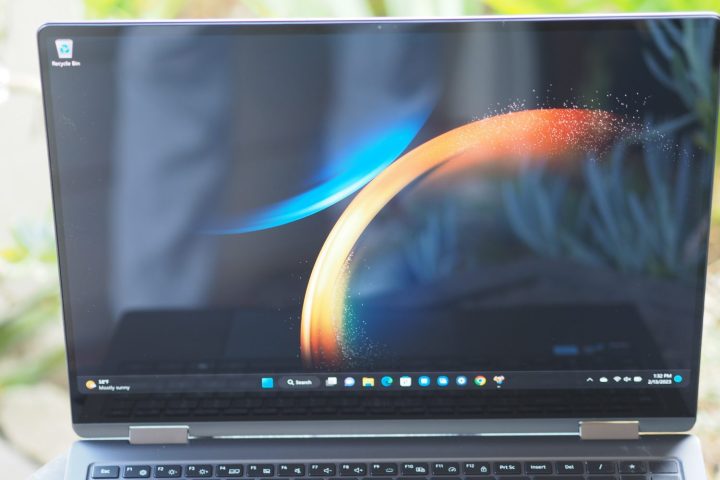
Samsung’s next-gen AMOLED X2 panels provide both higher 120Hz refresh rates and VESA ClearMR, which promises wider colors and truer blacks (an accomplishment for OLED technology, if it can be pulled off). The display is gorgeous out of the box, as are all OLED panels. Blacks are deep, colors pop without being oversaturated, and
According to my colorimeter, the AMOLED X2 display was comparable to other OLED panels, with one exception. For some reason, the colorimeter returned a 0:1 result for the contrast ratio. I’ve contacted both Samsung and Datacolor, maker of my Spyder X Elite colorimeter, to find out what might be happening here.
In any case, the display was bright and enjoyed wide and accurate colors. It’s as good an OLED display as you’ll find, although it didn’t live up to the claim of wider colors, and I think it’s safe to assume that its contrast is at least equal to the other OLED panels in our comparison group. I was interested in seeing if it was indeed higher than usual, but we’ll have to wait for a fix to find out. With OLED, though, it would likely be difficult to tell the difference in real-life use. The display supports VESA DisplayHDR 500, which gave it solid performance in playing
| Brightness (nits) |
Contrast | sRGB gamut | AdobeRGB gamut | Accuracy DeltaE (lower is better) |
|
| Samsung Galaxy Book3 Pro 360 (OLED) |
407 | N/A | 100% | 98% | 0.73 |
| LG UltraPC 17 (IPS) |
407 | 1,470:1 | 100% | 89% | 1.53 |
| Dell XPS 15 9520 (OLED) |
381 | 381,130:1 | 100% | 99% | 0.46 |
| MSI Creator Z17 (IPS) |
355 | 840:1 | 100% | 87% | 1.35 |
| Apple MacBook Pro 16 (IPS) |
475 | 475,200:1 | 100% | 90% | 1.04 |
Four speakers, including two 5-watt woofers and two 2-watt tweeters, put out plenty of volume with just a touch of distortion at full volume. Mids and highs were clear, and there was more bass than usual. The speakers can’t live up to the best available, which you’ll find on the MacBook Pro series and the Dell XPS 15 among Windows
If you need a 16-inch laptop for inking, the Galaxy Book3 Pro 360 is your best bet
Yes, the Galaxy Book3 Pro 360 performs well (although not as well as expected given its 13th-gen Intel CPU), gets great battery life, and enjoys a gorgeous OLED display. As a convertible 2-in-1, though, its standout feature is that it’s thin and light enough to use as a tablet more comfortably than its competitors. In fact, it’s one of the thinnest 16-inch
Pricing is confusing right now, with a much more attractive preorder price than Samsung indicates will be the long-term pricing. That means it’s likely to be pretty expensive once it hits the mainstream. But it’s still worth it for anyone who wants a larger display for creating digital notes and drawings.
Editors' Recommendations
- 9 best 2-in-1 laptops in 2024: tested and reviewed
- Samsung adding Auracast and 360 Audio to more TVs, phones, and earbuds
- This tiny ThinkPad can’t quite keep up with the MacBook Air M2
- All of Samsung’s videos from today’s Galaxy Unpacked event
- The Galaxy Book 3 Ultra is Samsung’s most powerful laptop ever

